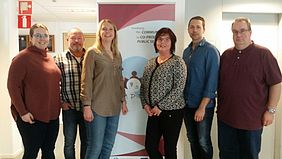The Association of Local Authorities of Västernorrland County (ALAV) have implemented various e-health technologies for dependent elder people and home care employees.
In the process ALAV has worked with 7 Local Champions in 7 different municipalities. They received training about e-health and after exploring municipalities most immediate needs, they participated in the selection of 4 technologies/products to work actively with. The services chosen and implemented are the following:
#1 Safety Cameras
Dependent elders who need someone to look after them during the night have traditionally been visited by home care staff. In rural areas with long distances a lot of staff time during nights have been spent in the car driving between clients. Instead of physical visits clients now have a web camera in their home enabling home care to look after them without need to travel.
Benefits:
- For clients: Allows the person to have undisturbed sleep. Many clients tell how they wake up when home care comes to visit at night. For older people, undisturbed sleep is important. Not sleeping well increases risk for fall during the day.
- For home care workers: Saves time, less driving, same kind of service delivered in much shorter time, safer for staff to not be out on icy roads at night.
#2 Digital Diapers
There are 2 target groups: (1) older persons with dementia living in nursing homes, and (2) persons who live independent but have cognitive and/or physical dysfunction in combination with bladder dysfunction causing them to need assistance for toilet visits.
A digital diaper with sensors that detect urine is used, to find out the individuals pattern for urination. Many persons with dementia have a diaper, and it gets uncomfortable, can smell and sometimes the diaper leaks which leads to inconvenience for the person regarding wet clothes and changing wet sheets on the bed.
Through IMPROVE 2 municipalities had the chance to test the service in real living lab.
#3 Key free Home Care
A service that uses digital technologies to better and more secure handle access for remote home carers. The target group are the clients with home care, living in their own homes.
Benefits:
- For clients: Increased security for client. It is not unusual that keys are lost or stolen, causing risk of unauthorized persons getting their hands on clients keys, or causing need for clients to change locks for safety. All home care workers can access the home, it is logged electronically who have been there, preventing unauthorized persons from entering. In case of emergency staff can drive to and enter client’s home immediately, instead of having to drive to the home care office to fetch a key, which in rural area can be quite long distance and take long time.
- For home care workers: All staff can enter clients home when needed. No need to collect and handle hundreds of keys. Saves time. In case of emergency the nearest health workers can go to the client, not the one who has the key, or someone who has to drive to the key locker fetching the key. Saves driving time and time for handling keys and troubles related to keys. Increase security.
#4 Digital Patient Care Planning
Using distance-spanning technology with webcam for planning. When rural patients go home returning from hospital, they need home care. This process involves hospital nurse, patient, family members, health care/social workers (such as home care, nurses, occupational therapists, physiotherapists), case officers and sometimes others. Planning sessions occur at the hospital but families want to be involved on it.
Benefits:
- For clients: Promotes higher level of participation for clients and their kins. Planning affects every day life for the client and his or her family. It is desired by many to have their family members attending the planning sessions. But in some areas, many clients have over 100 km to the hospital. When doing it digitally persons living in other parts of the country can attend.
- For home care workers: Saves a lot of travel time for workers. In some areas, many municipalities have over 100 km from their offices to the hospital. Municipal health workers and case officers spend long hours driving. Saving costs for cars, fuel, less emission and air pollution. More important yet, in these times with lack of health workers, every saved travel hour means an hour that can be put into supporting, serving and helping clients instead of driving.
If you are interested in these services and want more information, you can contact:
The Association of Local Authorities in Västernorrland, Sweden.





